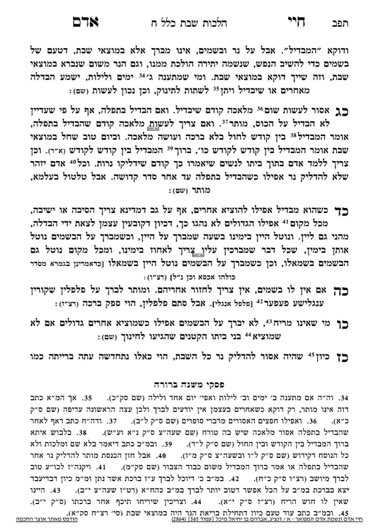We are continuing in siman 25, discussing the besamim for havdalah. We left off discussing the bracha of hanosein reiach tov bapeiros, and whether one who says atzei besamim on such a fruit has fulfilled their obligation or not. It is a machlokes whether one is yotzei bedieved or not. Therefore, one should say the bracha of borei minei besamim, because according to all opinions, one is yotzei with that bracha.
Similarly, if one is unsure whether the correct bracha on a smell is isvei besamim or atzei besamim, they should say borei minei besamim, because isvei besamim does not cover something which is atzei besamim, and vice versa.
On Motzei Shabbos, the minhag is to always make the bracha of minei besamim on the besamim. One suggestion is that since everyone needs to make havdalah, even those who are not necessarily learned, they may get confused and end up reciting the wrong bracha. This does not mean that the bracha on that item becomes borei minei bisamim at all times; it is only for Motzei Shabbos.
Another scenario where borei minei besamim is always made is when one has a mixture of different spices consisting of different brachos. One does not separate the spices in order to make different brachos, but rather makes borei minei besamim on the entire mixture.
We are going to return to discuss peppercorns (shiur S244). The question comes up in regards to the bracha on cloves and cinnamon as well (which we will discuss in upcoming shiurim). Cloves grow on a tree. As the fruit buds, there are little protrusions which come out of the flower. These are removed and hardened, and are known as cloves. If they remained on the tree, they would produce some sort of fruit. In essence, the clove is the “fruit” of the tree. We learned in hilchos brachos that “fruit” does not just mean the literal fruit of a tree, but its (primary) product. Thus, as the primary fruit of the tree, the bracha on cloves arguably should be hanosein reiach tov bapeiros. A leaf of the tree, which is a secondary product of the tree, would be atzei besamim, but the clove should be hanosein reiach tov bapeiros. Sure enough, the Shulchan Aruch paskens that the bracha on cloves is hanosein reiach tov bapeiros.
Regarding hadassim, the primary purpose of hadassim is not to be used for smell, but for other purposes. Therefore, its primary bracha is atzei besamim. If one makes a mixture of hadassim and cloves, the correct bracha is borei minei besamim, due to it being a mixture.
Thus, regarding havdalah, one suggestion is to specifically use a mixture of hadassim and cloves. There is anyways an opinion that it is appropriate to use one’s leftover hadassim for havdalah, because of the concept that it is appropriate that something used for a mitzvah should be used for another mitzvah (once the first mitzvah is finished). This is similar to the idea of using the lulav as fuel for burning the chametz, so that the lulav is now being used for the mitzvah of biur chametz.
Summary
When there is a machlokes about the correct bracha on besamim, one recites borei minei besamim out of safeik.
One recites borei minei besamim on a mixture of besamim of different brachos
Regarding havdalah, the minhag is to always recite borei minei besamim.
Regarding havdalah, one suggestion is to use a mixture of cloves and hadassim.



